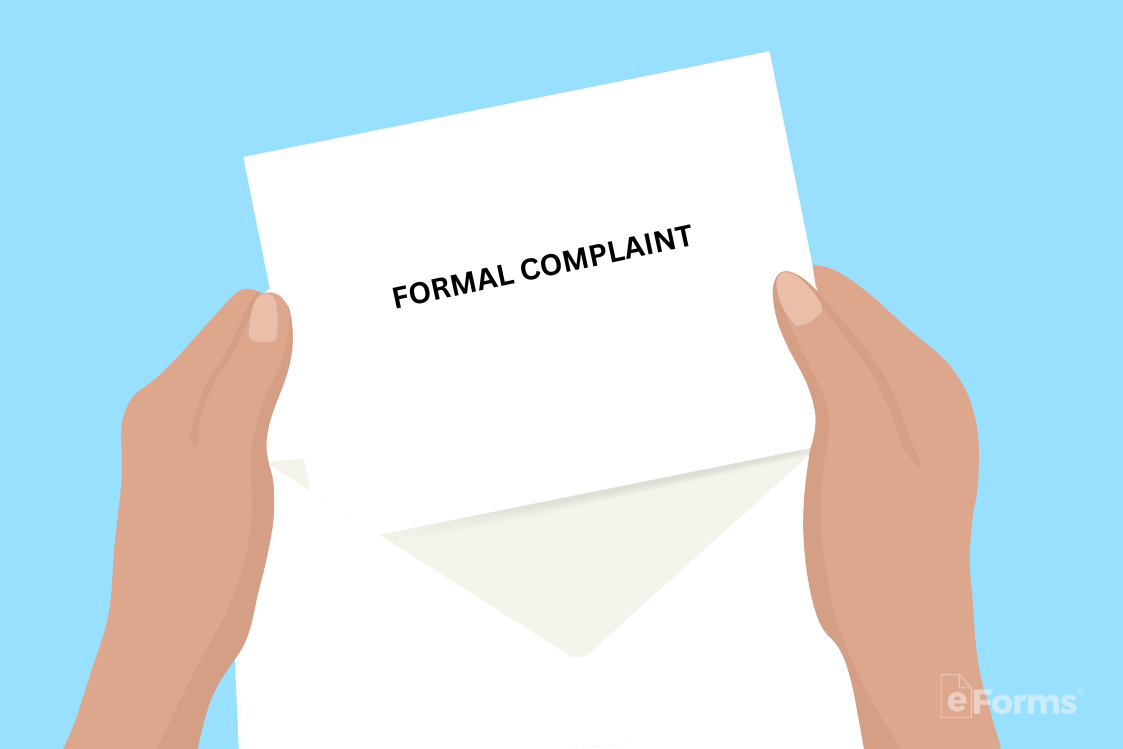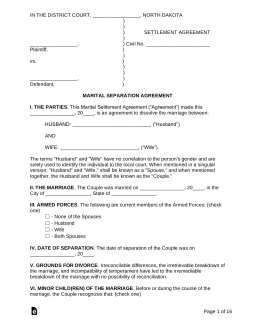Updated August 29, 2023
A North Dakota marital settlement agreement is a document that enables two spouses to settle important affairs relating to their divorce. A settlement agreement covers property and asset division, debts and liabilities, alimony or other spousal support, child support, child custody, and other pertinent issues. This contract can be executed by the spouses alone or with the help of attorneys or a mediator. Due to the severe implications of a settlement agreement, using legal counsel or mediation is recommended. While a signed marital agreement is legally binding, it is not an official court order nor does it define the couple’s legal separation or divorce.
Table of Contents |
Divorce Laws
Statutes – Chapter 14-05 (Divorce)
Alimony (§ 14-05-24.1) – When determining the amount of spousal support one spouse will pay the other after divorce, the court will consider a number of circumstances and factors to produce a fair and just support order.
Alimony Calculator – calculators.law
Child Support (Administrative Code § 75-02-04.1 and (Century Code § 14-09-09.7) – The obligor (non-primary caregiver) will be ordered by the court to make child support payments calculated by using the guidelines in the statutes linked above.
Child Support Calculator – North Dakota Department of Human Services
Division of Property (§ 14-05-24) – The court will order an equitable distribution of property upon granting a divorce decree. This allows both spouses to acquire their fair share of the marital property and assets, and not a perfect 50-50 split.
Grounds for Divorce (§ 14-05-03) – The following actions are grounds, or “cause”, for divorce:
- Adultery
- Extreme cruelty
- Willful desertion
- Willful neglect
- Abuse of alcohol or controlled substances
- Conviction of felony
- Irreconcilable differences
Interim Support (§ 14-05-23) – During the proceedings of a divorce action, either party may be required to pay temporary spousal or child support to the other party, which may include attorney or other legal fees.
Residency (§ 14-05-17) – The spouse filing for divorce (referred to as the “plaintiff”) must have resided in the state of North Dakota for six (6) months preceding the commencement of the action or, if that does not apply, six (6) months preceding the entry of the decree of divorce.
Separation (§ 14-05-03.1)- Spouses are not required to be separated before filing for divorce. A decree of separation, which is similar to divorce but does not allow the spouses to remarry, may be requested by either spouse and ordered by the court temporarily or permanently on the same grounds as divorce.
Divorce Forms
- Where to File – North Dakota District Court
- Filing Fee – $80
- How Long Does it Take? Thirty (30) to ninety (90) days
Uncontested Divorce with No Children:
- Summons (Form 1)
- Complaint (Form 2)
- Settlement Agreement (Form 3)
- Property and Debt Listing (Form 4)
- Admission of Service (Form 5)
- Affidavit of Proof (Form 6)
- Findings of Fact, Conclusions of Law and Order for Judgment (Form 7)
- Judgment (Form 8)
- Confidential Information (Form 9)
- Notice of Entry of Judgment (10)
Uncontested Divorce With Children:
- Summons (Form 1)
- Complaint (Form 2)
- Settlement Agreement (Form 3)
- Property and Debt Listing (Form 4)
- Confidential Information (Form 5)
- Admission of Service (Form 6)
- Affidavit of Proof (Form 7)
- Findings of Fact, Conclusions of Law and Order for Judgment (Form 8)
- Judgment (Form 9)
- Notice of Entry of Judgment (10)
How to File for Divorce in North Dakota (7 steps)
- Conditions for Uncontested Divorce
- Settlement Agreement
- Complaint
- Additional Forms
- Serve Defendant
- Filing With Court Clerk
- Judgment
1. Conditions for Uncontested Divorce
- Spouses are in communication with each other;
- Spouses are not in any disagreements regarding the divorce and related issues;
- At least one (1) spouse has lived in North Dakota for the past six (6) months;
- All children have lived with a spouse in North Dakota for the past six (6) months (if applicable);
- No other legal actions are pending between the spouses;
- Neither spouse is in the military or, if they are, they are not deploying or deployed; and
- Neither spouse has a protection or restraining order in effect.
2. Settlement Agreement

In order for the spouses to file an uncontested divorce, they must have a marital settlement agreement in place. Settlement Agreements (Form 3) are provided by the North Dakota Legal Self-Help Center, which is a legal resource provided by the State of North Dakota Courts. There are two different agreements, a Settlement Agreement (Spouses With No Children) and a Settlement Agreement (Spouses With Children). Completing a settlement agreement ensures the court that both parties have come to an understanding with regard to issues such as property division, spousal support, child support, and child custody. In addition, either spouse can take this opportunity to notify the court that they will be changing their name after the divorce (Agreement With no Children – Article 24/25 | Agreement With Children – Article 26/27). Requesting a name change during the divorce process means the spouse can avoid petitioning for a legal name change in a separate court hearing. After filling out the settlement agreement, Form 4 can be completed by using the information contained in the agreement (Property and Debt Listing (With No Children) | Property and Debt Listing (With Children)).
Note: It’s important to note that the North Dakota Self-Help Center is a public resource, and acceptance by the courts of all forms provided herein is not guaranteed. Legal counsel is always recommended.
3. Complaint

For the purposes of the divorce proceedings, the spouse filing the divorce action will be the plaintiff and the other spouse becomes the defendant. The plaintiff must complete the appropriate complaint form and summons form (provided below). The summons must be presented to the clerk at the district court in the county where the divorce is being filed. The clerk will sign and date the summons. Copies of the complaint and summons should be made so the originals can be kept for the parties’ records and the other copies can eventually be filed with the court.
With No Children:
With Children:
4. Additional Forms

After the complaint and summons are completed and the plaintiff has received the clerk’s signature on the summons, the following forms can be downloaded and completed:
With No Children:
- Confidential Information (Form 9) (completed and signed by both spouses)
- Affidavit of Proof for Stipulated Judgment (Form 6) (completed and signed by plaintiff before notary)
- Findings of Fact, Conclusions of Law and Order for Judgment (Form 7) (completed by plaintiff using information from Settlement Agreement (Form 3) – Do Not Sign)
- Judgment (Form 8) (completed by plaintiff using information from Settlement Agreement (Form 3) – Do Not Sign)
With Children:
- Confidential Information (Form 5) (completed and signed by both spouses)
- Affidavit of Proof for Stipulated Judgment (Form 7) (completed and signed by plaintiff before notary)
- Findings of Fact, Conclusions of Law and Order for Judgment (Form 8) (completed by plaintiff using information from Settlement Agreement (Form 3) – Do Not Sign)
- Judgment (Form 9) (completed by plaintiff using information from Settlement Agreement (Form 3) – Do Not Sign)


